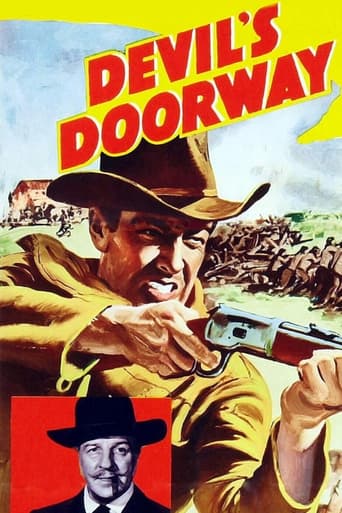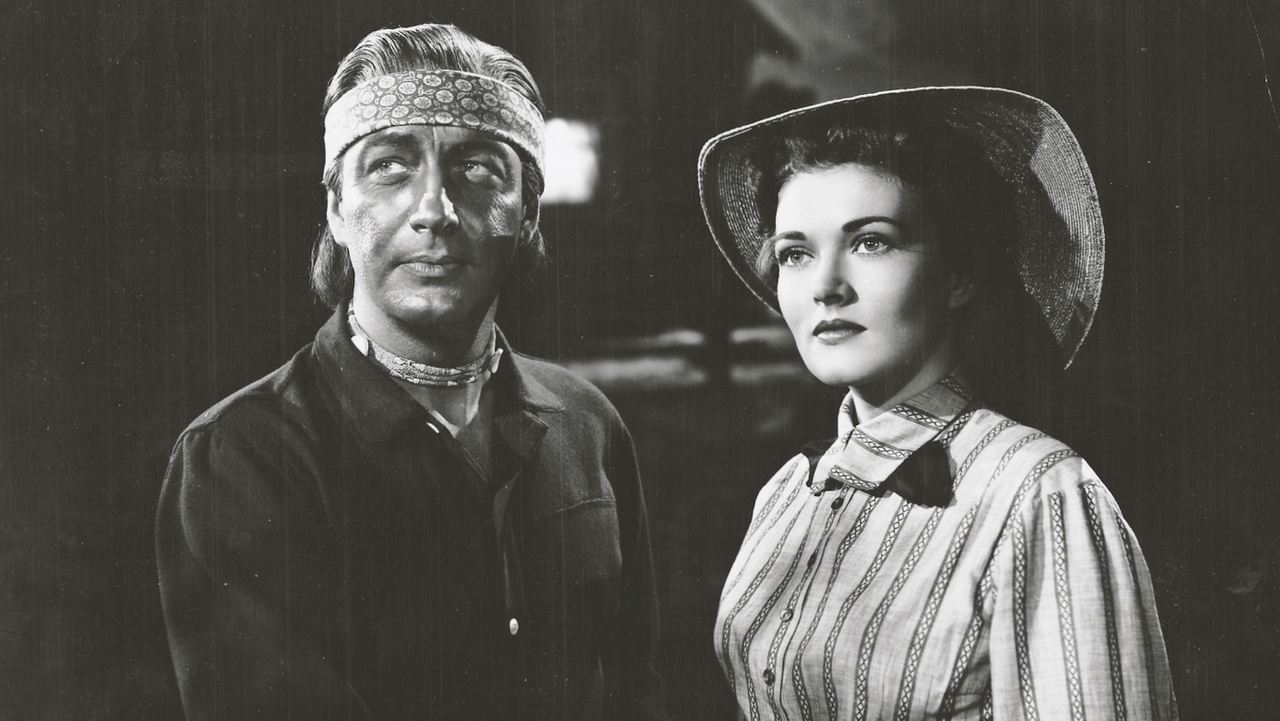wes-connors
In Wyoming, Native American Indian and Civil War hero Robert Taylor (as Broken Lance Poole) faces discrimination. When his father appears ready for the "happy hunting ground," Mr. Taylor can't get a doctor because he's an "Injun". White lawyer Louis Calhern (as Verne Coolan) wants to take away the land Taylor inherits. Taylor hires female attorney Paula Raymond (as Orrie Masters) to help and they are mutually attracted. Taylor learns that, as an Indian, he is not a United States citizen and has no right to his own land. Sheepherding homesteader Marshall Thompson (as Rod MacDougall) moves in, and the conflict gets violent..."Devil's Doorway" opens with some serious reservations about Taylor's portrayal of a Native American. It doesn't help that his make-up shades up inconsistently in different scenes. But, after about thirty minutes, when he's in full "red-skin" dress, Taylor creates an appealing and believable character. Taylor's stoic mid-life screen persona matches the role perfectly, and he responds with one of his best performances. Also lifting this film from the doldrums is director Anthony Mann, who gets photographer John Alton under your skin with some beautifully framed and staged scenes. The "pro-Indian" theme was not new, but had become rare.******* Devil's Doorway (9/15/50) Anthony Mann ~ Robert Taylor, Paula Raymond, Louis Calhern, Marshall Thompson
jwardww
It is shocking that this movie was able to be green-lighted in the Hollywood of 1950. But is the point of view presented here really sympathetic to the "Indians" or deterministic, as was the 1957 movie Something of Value, which told a similar tale about the Mau Mau rebellion in Kenya. Should one be impressed by the subject matter or appalled that the fate of Native Americans was actually less important to these producers than their prurient fascination with an implied hook-up between Taylor (a red man rocking a page boy wig, his screen test for Ivanhoe) and Paula Raymond (the whitest woman in his world)? Whatever the impetus for the film, the acting is quite affecting all around. But the story is so relentlessly bleak and heartbreaking for a 1950 film, that one might almost imagine it as the retro nightmare of the misanthropic, Lars von Trier. The monstrous unfairness of the stolen land, the inhumane displacement of a very sympathetic group of Native Americans and their eventual annihilation is presented with no sugar coating in a way that has yet to be done for other famous sagas of injustice, such as American Slavery, the Irish potato famine or today's beleaguered Palestinians. There could not be a happy ending to any of these stories and this creative team deserves credit for realizing that about Devil's Doorway.
jpdoherty
A dark grim yet gritty movie is probably the best way to describe this fairly forgotten and under appreciated jewel of a western. Produced by Nicholas Nayfack for MGM in 1950 the picture - just like "Winchester 73" and "The Gunfighter" made the same year - marked the coming of age of the American western. DEVIL'S DOORWAY was the first movie which undertook to depict - in graphic terms - the plight of the native American in the west of the 1860s. It was also the first western to be directed by Anthony Mann who alongside John Ford would become the genre's most iconic director with his masterpiece "Winchester 73" and thereafter with his fruitful working relationship with actor James Stewart that would produce some of the finest westerns ever made like "Bend Of The River", "The Far Country" and the brilliant "Naked Spur". Nicely written for the screen by Guy Trosperm DEVIL'S DOORWAY was stunningly photographed in glorious Black & White in Aspen, Colorado by John Alton and was complimented with a splendid atmospheric score - featuring an exciting Indian motif - by Russian composer Daniele Amfitheathrof.With the Congressional Medal of Honour pinned to his Union tunic distinguished Shoshone Indian Sergeant Major Lance Poole (Robert Taylor) returns home from the war between the States to his people in his beautiful valley of Sweet Meadow. He is greeted by his aged and ailing father (Fritz Leiber) ("You are home - you are again an Indian"). But prejudice against the tribe is beginning to take hold in the nearby town instigated and then exacerbated by a shady Indian hating lawyer Verne Coolin (Louis Calhern). Things really come to a head when sheep-men arrive and need to graze their herds on Sweet Meadow but Lance will not allow it and orders them off his property ("This is my land and you're trespassing"). However they are encouraged by Coolin to take the land since the Homestead Act of the period states that it is forbidden for an Indian to own any land. An enraged Lance takes up arms and leads his people against the interlopers (a well executed battle scene). Finally with many deaths on each side the army are sent for to quell the fighting which leads to a tragic finale. Lance settles his score with Coolin before the final shootout with the army which sees him and his braves being killed, his village destroyed and the tribe - what's left of them - being escorted to the reservation.DEVIL'S DOORWAY is a superb western and deserves to be rediscovered. With Mann's earlier noir successes "T Men" (1947) and "Raw Deal" ('48) DEVIL'S DOORWAY contains wonderful noirish moments of outstanding quality such as in the bruising fist fight sequence in the Saloon between Taylor and gunman James Milican with its low angle camera and arresting use of light and shadow and again later for scenes inside the dimly lit Indian shacks. The acting throughout is splendid all round. Taylor arguably gives the performance of his long career in an unusual bit of casting. Eschewing his handsome MGM glamour-boy image (he was Gable's chief rival at the studio) he turns in a powerful and striking portrayal of great depth and substance. His performance as a man who sees his beloved valley being ripped out from under him and his people is heartfelt and sincere. Excellent too is Louis Calhern as the antagonistic racist lawyer. His part not being very far removed from his brilliant shady lawyer in the studio's "Asphalt Jungle" the same year.So here is a powerfully evocative and accomplished movie that was strikingly bold for its time and today remains compelling in its stark presentation. Directed by a man who was on the verge of western movie greatness DEVIL'S DOORWAY is a movie that shouldn't be missed by anyone who cares about the American western. It is a movie that with some reassessment and a little more exposure could easily become one of Hollywood's greatest achievements and perhaps even Mann's real masterpiece. A movie that makes the final and prophetic line in the picture that bit more fitting.......... "IT WOULD BE TOO BAD IF WE SHOULD EVER FORGET".
Spikeopath
Devil's Doorway is directed by Anthony Mann. It stars Robert Taylor as Lance Poole, a Shoshone Indian who returns home to Medicine-Bow from the American Civil War after a three year stint, and a veteran of three major conflicts. Awarded the Congressional Medal of Honor he rightfully expects to be able to retire to a peaceful life back on the family land. However, all his hopes and dreams are shattered by bigotry and greed as new laws are ushered in to deprive the Native Indians land rights.Biting and cutting, Devil's Doorway is a Civil Rights Western that, boldly for its time, looks at the injustices done to Native Americans. Very much grim in texture, it's no surprise to see Anthony Mann at the helm for this material. Mann of course would go on to become a Western genre darling for his run of "Adult Westerns" he would do with James Stewart. Prior to this Mann had showed himself to have a keen eye for tough pieces with dark themes in a few well regarded film noir movies. So this was right up his street, in fact a glance at his output shows him to be something of a master when it comes to showing minority groups sympathetically. MGM were nervous tho, unsure as if taking the Western in this direction was the way to go, they pulled it from release in 1949. But after the impact that Delmer Daves' similar themed Broken Arrow made the following year, they ushered it out and the film promptly got lost amongst the plaudits for the James Stewart starrer. That's a shame because this is fit to sit alongside the best work Mann has done. Filmed in black & white, the film has beautiful landscapes that belie the bleak road the movie ultimately turns down. Shot on location at Aspen and Grand Junction in Colorado (the talented John Alton on cinematography), the film also manages to rise above its obvious eyebrow raising piece of casting. Robert Taylor always had his critics, hell I'm sometimes one of them, but here as he is cast against type as a Shoshone Indian, he gives the character conviction and a stoic nobility that really makes it work. Some of his scenes with the beautiful Paula Raymond (playing his lawyer Orrie Masters) are a lesson in maximum impact garnered from emotional restraint. You will be aware of the fluctuating skin pigmentation he has throughout the movie, but honestly look into his eyes and feel the confliction and loyalty and you really will not care.Scripted by Guy Trosper (Birdman of Alcatraz), the screenplay is unflinching in showing how badly the Native Americans were treated. Throw that in with Alton's other gift, that of the dusty barren land shot, and you got a very film noir feel to the movie. Something which not only is unique, but something that also showed a shift in the Hollywood Oater. We now get brains to match the action and aesthetics of the Western movie. Not that this is found wanting for action, Mann doesn't short change here either, with a dynamite led offensive purely adrenaline pumping. A fine fine movie, an important movie in fact. One that is in desperate need of more exposure. Still awaiting a widespread home format disc release, I quote Orrie Masters from the movie..."It would be too bad if we ever forget".... that applies to both the theme of the piece and the actual movie itself. 9/10


 AD
AD



